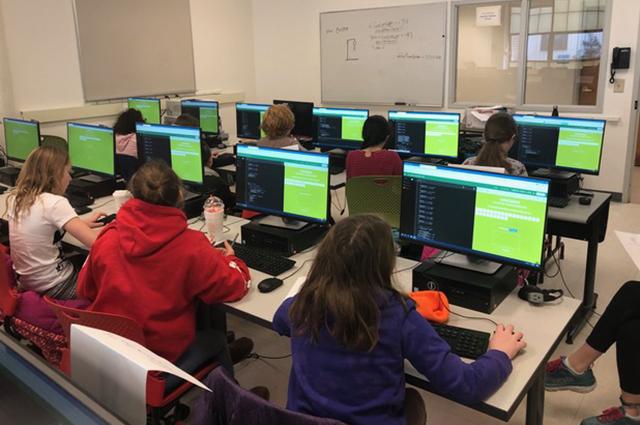The next generation of coders

By Tufts Department of Computer Science
Historically, women and girls haven't always been made to feel welcome in environments dedicated to science and technology. Though more and more schools are beginning to encourage girls to try out coding, gender disparity still exists in the field. That's where Tufts Girls of Code comes in.
While Tufts' Department of Computer Science is committed to attracting and retaining women at all levels in the department, Tufts Girls of Code works with school-aged girls who aren’t even thinking about college yet. Girls of Code brings local girls, often Girl Scout troops, to the labs in Halligan Hall to introduce them to programming. They teach, they guide, and they provide pizza. Tufts Girls of Code is a Tufts-specific club, run entirely by Tufts students and a few recent alumni, and it provides its services free of charge.
Genevieve Silverman, A19, is one of the two Girls of Code coordinators and was once one of those girls with an interest in computer science that no one encouraged when she was young. She was a sophomore at Tufts before she tried out computer science for the first time, taking Comp 11 and declaring a computer science major all in the same semester, and she was frustrated that she hadn’t encountered the field before enrolling at Tufts. Girls of Code, with its mission of providing a space for girls to have that exposure, making it interesting and encouraging, and leaving them excited and feeling empowered about it, provides the kind of outlet that Silverman wishes she had had.
How do they do it? Girls of Code workshops make the material relatable and easy to comprehend, but also leave 30-60 minutes at the end for the girls to explore how to customize their projects and make them uniquely theirs. This exploration captures student interest, showing them how they can use their creativity in computer science and how to implement their ideas. Tufts Girls of Code teachers also demonstrate ways to search for information online so they can take their skills home. For the youngest girls, who are about 10 years old, Tufts Girls of Code tailors the workshops with projects such as game building or make-your-own adventures with Harry Potter characters.
Girls of Code is finding success, which is evidenced by the fact that about half of the students are repeat attenders. Some come back and talk about things they’ve done elsewhere; one Girls of Code student will be a counselor at a summer camp that teaches coding. Others are getting involved with coding workshops at Cambridge public libraries.
A lot of work goes into running a successful workshop. Right now, Tufts Girls of Code is managed by four people: two curriculum developers (alumni Winona DeSombre and Emma Plankey, both A18) and two coordinators (Silverman and Caroline Kaufman, A20) who devote 20-35 hours to develop the lesson for each course. They prepare starter code and packets to hand out to their young students. The student coordinators crowdsource volunteers to be workshop leaders and teaching assistants. Leaders present all the material and lead students from one activity to the next; TAs circulate around the classroom and assist students during each workshop.
Silverman is about to graduate, but she knows that Girls of Code is in good hands. Kaufman and Rachel Ginsberg, A21, are poised to be the new coordinators, and there are still active alumni to support the group next year. While Silverman is leaving Massachusetts, the company where she has already accepted a job is supportive of this kind of activity, so she’ll be looking for a suitable outreach organization in Silicon Valley.
As for the girls who are learning to code today? The Department of Computer Science hopes to see them back at Tufts in a few years as CS majors.
Department:
Computer Science